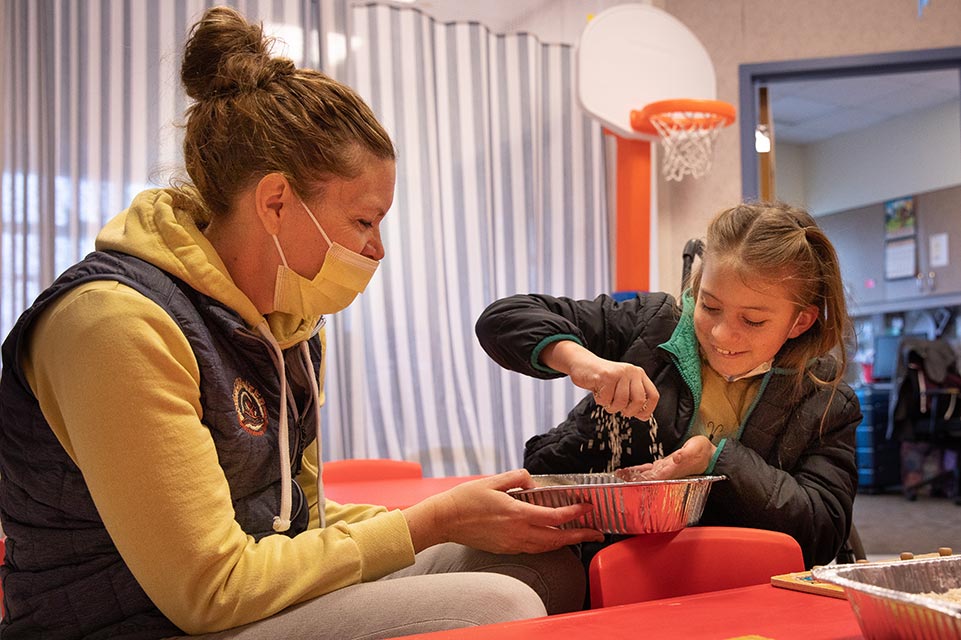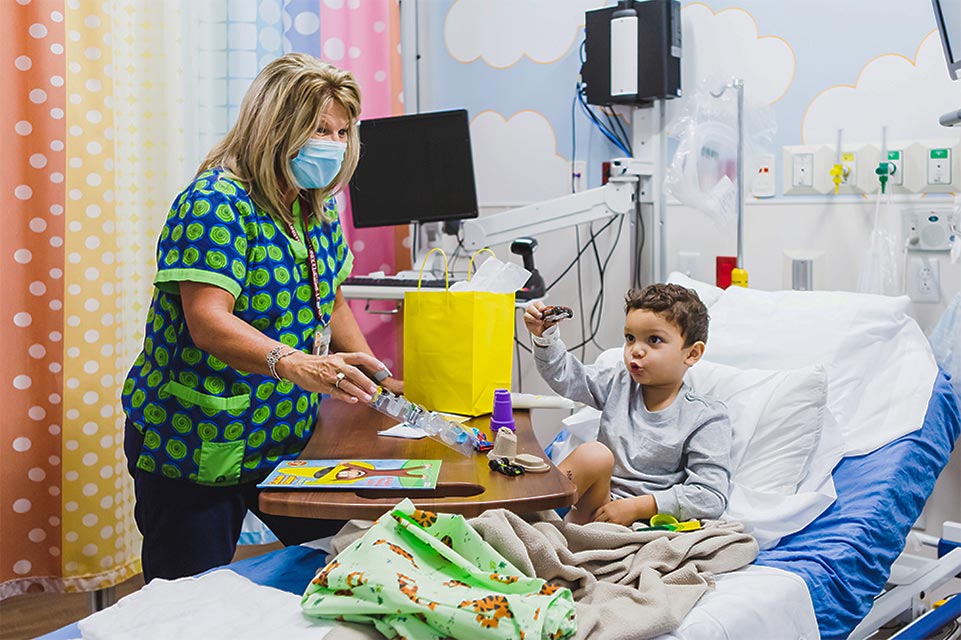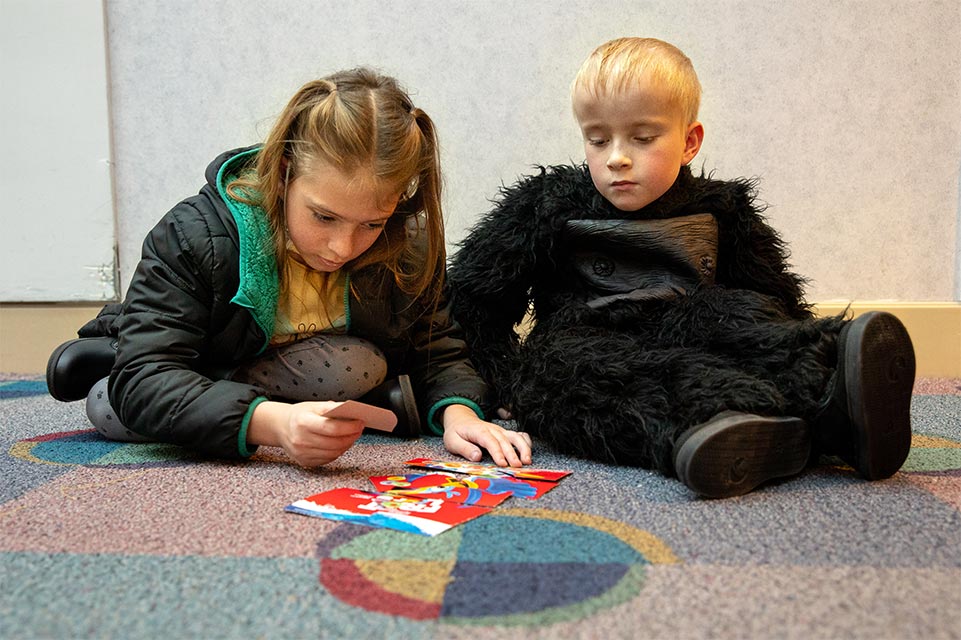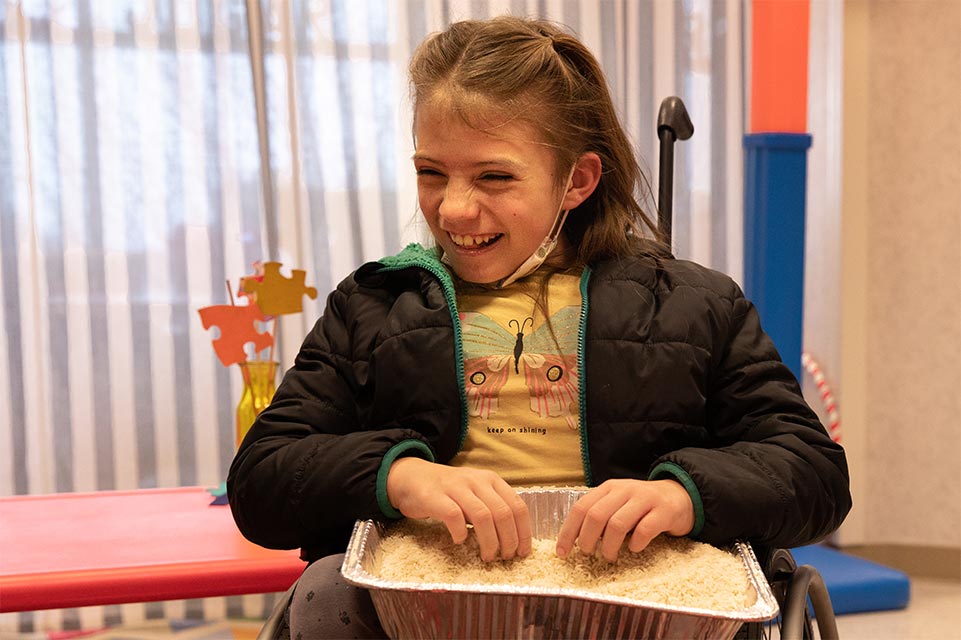Recreational Therapy Provides Comforting Fun for Shriners Children’s Patients

Shriners Children's Salt Lake City recreational therapist Laura Hollingshead and patient Whitney work through a fun activity together.
Surgeries, minor procedures and even clinic visits can bring on fears and anxieties for young patients. Shriners Children's employs recreational therapists across the country to help calm nerves and promote comfort for our patients.
Research shows that children who engage in therapeutic play are better prepared for medical procedures, experiencing less fear and anxiety leading up to major appointments. Recreational therapy invites our patients to channel their energies toward the things that make them happy.
Recreational therapists at Shriners Children’s are educated and clinically-trained to evaluate patients’ conditions related to illness and injury, and intervene in ways to help maximize their social, mental and physical health while improving patient care, satisfaction and overall experience for the whole family.
There are many benefits to recreational therapy. Recreational therapy:
- Helps patients and family members understand what is happening and what to expect.
- Reduces stress and anxiety caused by a clinic visit, medical procedure or surgical visit.
- Helps patients develop trust with the medical staff.
- Helps patients and family members develop ways of coping.
- Gives the patient a sense of control over what is happening to his or her body.
- Aids in communication.
- Provides education, distraction and diversion.
- Provides opportunities for purposeful therapeutic play.

Research conducted at Shriners Children’s Lexington has shown that medical play before and after surgery not only reduces fear and anxieties, it has proven to reduce pain and improve comfort for patients.
Recreational Therapy Reduces Post-operative Pain at Shriners Children’s Lexington
In her more than three decades with Shriners Children’s Lexington, recreational therapist Frazann Milbern has seen firsthand how recreational therapy benefits patients.
She recalled one early-morning procedure in the ambulatory surgery center (ASC) as a perfect example.
“The patient came into the ASC, upset and crying,” she said. “It was early morning. The patient couldn’t eat or drink before the procedure. They were scared and in a new place.”
That is typical for children facing surgeries and procedures but this is also where recreational therapists shine, Milbern said. Patients can use play to express emotion, learn and interact. When preparing for surgery, play can help children understand and cope with their hospital experiences.
“I talked with the patient and I started a session incorporating medical play with a bear the patient brought from home,” she recalled. “During this session, we bandaged the bear to have a splint on like the patient would after surgery. This process decreased the patient’s anxiety tremendously. By having the bear next to the patient in the pre- and post-operative area, the staff were able to ask about the bear, which encouraged the patient to talk about surgery and not be scared.”
The medical distraction play therapy program begins pre-operatively and includes both the patient and the caregiver in an effort to reduce post-operative opioid usage. Medical staff incorporate the expertise of recreational therapists into a program designed to teach patients and caregivers multimodal therapies aimed at recognizing early warning signs of pain, and dealing with pain in ways other than the usage of opioids.
“When possible, we start with teaching prior to surgery, when the patient is being seen in our outpatient clinic,” said Beth English, a recreational therapist at Shriners Children’s Lexington. “We explain what the outpatient surgery day will be like in a simple, honest and child-friendly way. We answer the patient’s questions using words they understand. We provide medical play opportunities to give them exposure to things they will see on their surgery day, and send them home with an educational outpatient surgery coloring book to read with their parents.”
On the day of the procedure, patients can bring items to provide comfort, which can then be incorporated in medical distraction play.
“The day of surgery in pre-op, we provide the patient with choices so they have a sense of control,” English said. “We ask, ‘What do you want to play?’ or ‘What do you want to watch on TV?’ etc. We offer a variety of age-appropriate distraction (i.e. a stuffed toy, coloring, Play-Doh, Lego building, crafts, toys or iPads) which we play in pre-op to decrease anxiety for surgery and for distraction during the wait. We continue distraction post-op as needed as part of our non-pharmaceutical distraction therapy.”
Research conducted at Shriners Children’s Lexington has shown that medical play before and after surgery not only reduces fear and anxieties, it has proven to reduce pain and improve comfort for patients. According to the research, prior to implementation of the medical play distraction program, only 60% of post-operative patients at Shriners Children’s Lexington reported a pain score of less than 4 compared to more than 96% afterward.
Customer satisfaction scores further prove the benefits of distraction therapy. Press Ganey scores indicated satisfaction with the degree of pain control post-operatively increased from a mean score of 81 to more than 99 following medical play therapy.
“Age-appropriate distraction facilitates coping, helps manage pain, decreases the use of pharmacological methods and builds trust between the staff and patient,” English said. “It is so rewarding when our patients have a positive experience with surgery, and hearing compliments from the families expressing the difference that recreational therapy distraction has made.”

Whitney and Cole work together to solve a puzzle to lead them to their next activity.
Fostering Relationships through Recreational Therapy and Fun at Shriners Children’s Salt Lake City
After being a recreational therapist at Shriners Children’s for 22 years, Laura Hollingshead knows how crucial social growth is to a patient's overall well-being, which is why she created “therapeutic playgroups.”
“Our therapeutic playgroups consist of patients who have just finished physical therapy, who are the same age, have the same diagnosis and a similar cognitive level,” Hollingshead said.
These playgroups not only function as a means to build on the things learned in physical therapy, but for patients to foster new relationships with kids who are just like them.
“I remember one time when I started a new group, I had a patient who was so shy about his hand and would hide it because it didn't function like other kids' hands,” Hollingshead said. “So once the rest of the group arrived, I asked everyone if they had a hand that didn’t quite work like others, and every single hand went up. Then almost immediately, this shy patient lifted his hand and rested it on the table because he knew he was in a safe space.”
Although Hollingshead created these groups to benefit her patients, the parents get just as much from them.
“These groups have allowed parents to create their own support network,” Hollingshead said. “They become a tight-knit group and meet socially outside of playgroup, go to each other with questions and empathize with each other.”
While playgroup always consists of the same structure: reading a book together, table activities, physical activities around the facility and ending with a group discussion about learning takeaways, Hollingshead keeps things fun and exciting.
“I never duplicate the activities and themes we do in playgroup because I want these families to know how invested I am and that it is worthwhile to come,” Hollingshead said.
One week the recreational therapy office could be decorated like the jungle; the next, it could be a pirate ship, and the kids have to use their strong muscles to swab the deck and then use their strong minds to find a hidden treasure. Hollingshead said this strategy helps keeps her patients engaged but also helps mask the fact that they are working hard.
“I love watching the kids push themselves after watching a peer do something and seeing their growth,” Hollingshead said.

Salt Lake City patient Whitney giggles during an activity at the spina bifida therapeutic playgroup.
Recreational Therapy is Fun for All Involved
For most recreational therapists, the best part of the job is that it is fun for them, too. For Hollingshead, the job feels like a dream come true.
“The other day my daughter asked me what my dream job was and I told her, without hesitation, that I already had my dream job,” Hollingshead said. “It is so easy for our patients and parents to get overwhelmed with the day-to-day medical appointments, and I am happy I get to be the one to provide them with fun experiences.”
That help comes in the form of something everyone loves and that connects generations: to play.
“I get to come to work and play,” English said. “Play allows children to use their creativity while developing their imagination, dexterity and physical, cognitive and emotional strength. Our clinic and ASC can sometimes be stressful places and out of the patients’ comfort zone. I am here for our children, to help them through this difficult time whether by providing procedural education, teaching controlled breathing, glittering a cast or holding a hand.”
At Shriners Children’s, the mission makes the job that much more enjoyable, English said.
“Our mission is and always has been to serve and better the lives of our patients,” she said. “Over the past 100 years, that has never changed. Shriners’ number one priority is to serve our children and families by providing them with the highest quality of care.”
Like English, Hollingshead also credits the Shriners Children’s mission when it comes to making recreational therapy enjoyable.
“My whole job is using recreation as a modality to increase quality of life, and Shriners Children’s mission of family-centered care has always played so well into that."
Whitney uses her strong muscles to gather faux firewood to build a campfire.
Whitney works on putting together a faux campfire.
Cole listens to a story while he works on an activity.
Whitney puts the finishing touches on her faux campfire.
Keep In Touch
Join our mailing list to stay up to date on everything that's happening at Shriners Children's.
